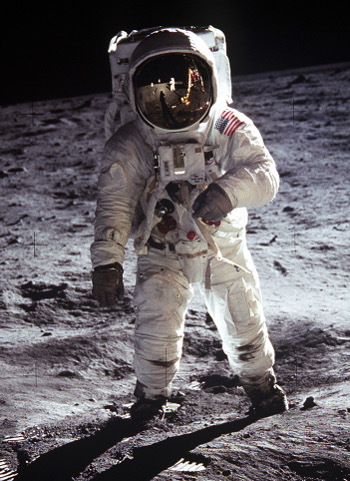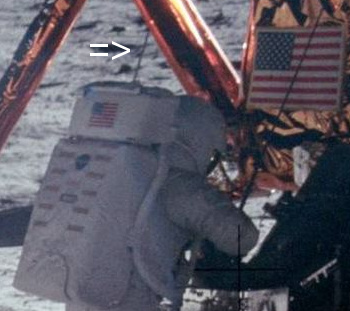Space Futurist
May 31, 2011
The motion of a
rocket is a classic textbook
physics problem. In
Newtonian mechanics, the
F = ma kind, a
mass experiencing a constant
force will have a definite
acceleration. This, of course, presumes a lot of things, like no
frictional forces acting on the mass; and, that the mass is unchanged. A rocket expending fuel will change mass, and its acceleration will change in flight under constant
thrust. The problem is usually a two-parter that concerns something about the motion after all the fuel is expended.
This textbook problem encapsulates the fundamental problem with a rocket - It needs to carry fuel, so you need to lift the fuel as well as the rocket. As an example, if we use the
Tsiolkovsky rocket equation and assume an
exhaust velocity of 4.5
km/s, about 88% of the initial mass of a single-stage rocket must be fuel for the rocket to reach low earth orbit (9.7 km/s).
What the world needs, and what
NASA needs in particular, is another way to boost mass into space. That's the idea of a short essay written by
Neal Stephenson in the April 7, 2011, issue of
Nature.[1] Stephenson's essay is one of several published reflections on the fiftieth anniversary of
Yuri Gagarin's flight in
Vostok 1, and the thirtieth anniversary of the first
space shuttle flight.

An icon of a happier time for NASA.
Astronaut Buzz Aldrin on the moon during the Apollo 11 mission.
Buzz appears to be missing his antenna. Read the text at the end of this article for the reason why.
NASA photo via Wikimedia Commons.
Most readers of this blog will recognize Stephenson, a noted
science fiction author. They won't think his presence is unusual in the company of the other reflection authors that includes
Dennis Bushnell, Chief Scientist at the
NASA Langley Research Center, and
Roald Sagdeev, former director of the
Russian Space Research Institute.
Stephenson's scientific bent is perhaps explained by his childhood environment. His paternal grandfather was a
physicist, his maternal grandfather was a professor of
biochemistry, his father is a professor of
electrical engineering, and his mother apparently has an undergraduate degree in
chemistry. Stephenson was especially interested in
computing at
Boston University, where he graduated in
geography with a physics minor.
This scientific background has enabled his writing complex, but enjoyable novels.
Cryptonomicon (1999) is my favorite, since his exposition of
mathematical genius is compelling, and quite believable. His books are not for the fainthearted. My paperback version of Cryptonomicon (Perennial/Harper Collins, 2000) is 918 pages long.
The main point of Stephenson's essay in Nature is as follows:
"Rockets got as good as they are ever going to get four decades ago. Measured in terms of specific impulse... no game-changing advances have been made since the Apollo programme."
Yes,
programme, not
program, just to remind us that we're reading Nature, and not
Science.
Stephenson writes that a new launch
paradigm is required, and he cautions that such exploratory work would not be undertaken by the private firms that are NASA's current darlings. NASA, and big government money, needs to be involved, but this NASA needs to be the
Apollo era NASA, not the "grab-bag of aerospace-industry support programs" that are the hallmark of the present NASA.
What are the alternative launch possibilities? As Stephenson writes, novel ideas have been fielded since the 1950s. These include the following:
• Laser propulsion
• Microwave propulsion
• Rail guns
• Orbital tethers
• Space elevators
• Aircraft- and balloon-assisted launch
• Scramjets
As they like to say in the business world, there are no problems, just opportunities. Stephenson sees NASA's current budgetary problems as a way to discard some politically-connected programs and redirect its mission to the things that really should matter.
Failure is not an option.
Now, about
Buzz Aldrin's missing
antenna in the photograph, above. When
Neil Armstrong snapped this photo of Aldrin, he placed Aldrin so high in the image that Aldrin's head was butted against the top of the frame and the antenna was cut off. We can't blame Armstrong, since he had a lot more on his mind at the time than artistic photo composition.
Photoshop wasn't released until 1990, so we can't really say that the image was photoshopped, but NASA added an additional black stripe just above Aldrin's head to place him more towards the center of the frame.
NASA never tried to hide this artistic enhancement, and they didn't use
photographic darkroom magic to add an antenna. That would have defiled historical accuracy, but a black stripe is just a black stripe. You can see an antenna in the image of Neil Armstrong working on the
Lunar Module, below.

Neil Armstrong works at the Lunar Module. His antenna is highlighted by the arrow.
Portion of NASA photo as11-40-5886, via Wikimedia Commons
The full story of the image editing of Buzz Aldrin's photograph, shown above, appears here.[4])
My father-in-law, Michael Perretta, worked on the Lunar Module at
General Electric's Light Military Electronics Division. I was told that the portion of the craft that remains on the
Moon contains a small plaque imprinted with his name among the many names of people who built the craft. One of these days, I'll go up there to check it out.
References:
- Classical Mechanics - Equation of motion for a rocket projected vertically upward, from Chapter 1, Herbert Goldstein, Classical Mechanics.
- Neal Stephenson, "Ditch the Rockets," Nature, vol. 472, no. 7341 (April 7, 2011), p. 29.
- Neal Stephenson page on Wikipedia.
- Eric M. Jones, "A Brief History of AS11-40-5903," NASA Web Site, December 9, 2005.
Permanent Link to this article
Linked Keywords: Rocket; physics; classical mechanics; Newtonian mechanics; mass; force; acceleration; friction; thrust; Tsiolkovsky rocket equation; exhaust velocity; km/s; NASA; Neal Stephenson; Nature; Yuri Gagarin; Vostok 1; space shuttle; Wikimedia Commons; science fiction; Dennis Bushnell; NASA Langley Research Center; Roald Sagdeev; Russian Space Research Institute; physicist; biochemistry; electrical engineering; chemistry; computing; Boston University; geography; Cryptonomicon (1999); mathematical; genius; Science; paradigm; Apollo era; laser propulsion; microwave propulsion; rail gun; orbital tether; space elevator; X-15; scramjet; Failure is not an option; Buzz Aldrin; antenna; Neil Armstrong; Photoshop; photographic darkroom; Lunar Module; General Electric; Moon; Herbert Goldstein, Classical Mechanics; AS11-40-5903.